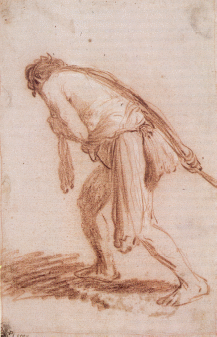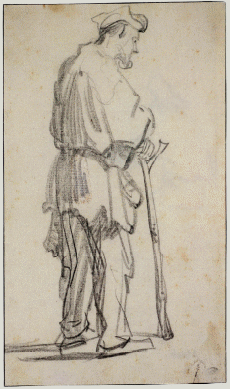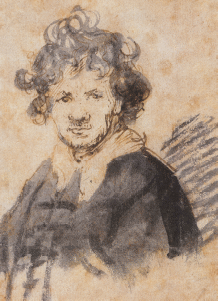The Artist’s Biography
Rembrandt van Rijn was a Dutch artist, painter, draftsman, etcher, engraver, and one of the most prominent representatives of the golden age of Dutch painting. He was born on July 15, 1606, in Leiden (Holland, the Republic of the United Provinces). The son of a miller, after a short study at the University of Leiden, Rembrandt devoted himself to art. He studied with the Dutch painter Pieter Lastman in Amsterdam in 1623 and worked in Leiden from 1625 to 1631. Having experienced the strong influence of Caravaggism already in his early, small-format works, he paid particular attention to the emotional and psychological possibilities of chiaroscuro. Along with religious painting, the portrait became the most important genre for the young Rembrandt. While diligently studying facial expressions, fixing even sharp, grotesque grimaces at that time, he made portrait images a constant accompaniment to his creative quests, thereby giving them an unprecedented sincerity of humanity. Having moved to Amsterdam in 1632, Rembrandt soon married the wealthy patrician Saskia van Uylenburg. He dedicated a number of his best images to his young wife.
From the 1640s, Rembrandt gradually abandoned the bravura external effects. In his works, the features of contemplation and mystical self-deepening intensified. In 1642, Saskia died, and in the second half of the 1640s, Hendrickje Stoffels, who had entered his house as a maid, became his faithful life partner. Since then, her image repeatedly appeared in the art of Rembrandt. The atmosphere of psychological revelation reigned in portraits, where the focus of interest was increasingly the face, or the face and hands emerging from the soft chiaroscuro. He abandoned the theatrical effects that his canvases had been filled with before and began to develop mystical images and plots. During that time, Rembrandt created many of the best self-portraits.
In the later years of his career, Rembrandt encountered financial difficulties. In 1657, the artist was declared bankrupt, and his property was sold at auction. He moved to a more modest dwelling in the Jewish quarter of Amsterdam. Hendrikje and his beloved son Titus died, but Rembrandt continued to work hard and unusually fruitfully. In the 1660s, due to poor eyesight, he almost stopped etching, concentrating mainly on drawing with a reed pen. On October 4, 1669, the great Dutch artist died in Amsterdam, leaving behind a rich cultural heritage. In the house where he lived in the late period of his life, there is the Rembrandt Museum today.
The Artist’s Drawings

As one of the selected drawings, “Man Pulling a Rope” can be considered, which is shown in Figure 1. The work is typical for the artist and made in the technique of individual strokes, representing a dynamic composition. In the story, Rembrandt shows the hard work of a man, as evidenced by such individual details as a bent back, tightly clenched hands, and the general position of the body. The drawing in the Baroque style corresponds to the early period of the artist’s activity. The minimalism on which the drawing is based emphasizes the precision of individual details, such as the scarcity of the character’s clothing or the tension of his muscles. This work is recognizable and often found when studying Rembrandt’s works. That dynamics and liveliness, which the drawing is imbued with, attracts attention and makes one review it in detail by focusing both on some strokes and on the general background.

Another drawing, which also refers to the early work of Rembrandt, is presented in Figure 2 and shows a poor man standing at an angle to the observer. The composition is similar to the previous one, but in this drawing, the artist uses a more pronounced line contrast. Narrower, more defined strokes highlight the character’s legs, while wider, more blurred lines add volume to the image. The drawing also refers to the Baroque style in which Rembrandt worked early in his career. Visually, the beggar’s image is perceived as enigmatic because the painter obscures most of the character’s face, and only part of the profile emerges. This is done to draw attention to the general structure of the drawing but not to the portrait resemblance. The work is perceived as dynamic and creates a sense of immersion in the era in which Rembrandt worked.

One of the artist’s early self-portraits is demonstrated in Figure 3. The youthful features of Rembrandt’s face are discerned through individual lines, but he recreates the general image and not the details. The tousled hair is one of the central elements of the drawing and is deliberately done with broad strokes. It is possible that Rembrandt wanted to show the typical fashion of the era in which he, as a young painter, worked. The general style of the self-portrait corresponds to the genre in which he drew at the initial stage of his career. As in other drawings, individual strokes are Rembrandt’s unique style, and despite the small number of details, the self-portrait is perceived as complete and voluminous.
References
Rembrandt’s drawings. (2018). Rembrandt Painting. Web.
Rembrandt van Rijn (1606-1669). (2022). National Gallery of Art. Web.
Rembrandt van Rijn: Biography and chronology. (2018). Rembrandt Painting. Web.
Strokes of genius: Rembrandt’s prints and drawings. (2022). National Gallery of Art. Web.